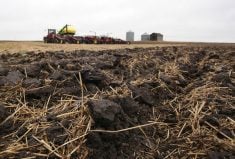There is one crop that has been largely ignored when it comes to talking about the ramifications of the war in Ukraine.
“The barley market is not getting the attention it deserves and I think it’s going to be very firm,” said Neil Townsend, analyst with FarmLink Marketing Solutions.
“It’s not getting much play because it’s not wheat and it’s not corn.”
Read Also

Fertilizer method’s link to emissions studied
A researcher says others studying greenhouse gas emissions aren’t considering how the loss of nitrogen into the atmosphere correlates with fertilizer application or if there is an impact to yield.
Ukraine is the world’s second largest barley exporter behind Australia, shipping out about six million tonnes per year.
He believes they may export half of that amount in 2022-23 and that’s being optimistic. If the ports reopen, sunflower oil, wheat and rapeseed are likely to get priority over barley.
His estimate is in line with UkrAgroConsult’s forecast calling for a 35 percent drop in barley production and a 47 percent decline in exports.
Townsend said there is a marginal tonne of production for many crops that serves as a tipping point for the market.
“The marginal tonne for barley is somewhere in Ukraine. If it doesn’t get produced, if it doesn’t get exported, the whole thing is out of whack,” he said.
“Now you’re relying on just an amazingly favourable outcome in Australia next year to keep everything possibly in balance.”
Russia is the world’s third largest barley exporter, shipping out about 4.5 million tonnes per year. It is unclear whether international sanctions will have any impact on Russia’s ability to export crops in 2022-23.
The barley market likely won’t get too much help from Canada. FarmLink is forecasting a decline in acres from last year.
Townsend thinks Canada will import less corn from the United States this year because there is going to be plenty of competition for that crop with the U.S. Department of Agriculture forecasting a four percent drop in acres.
That means more Canadian barley will find its way into domestic feed channels rather than the export market.
He wonders how customers like Saudi Arabia will cope with tight global supplies. It imports about seven million tonnes per year, mostly from the European Union, Russia and Ukraine.
“That’s just a huge hole,” he said.
They may be forced to import more from Australia.
“What’s the ocean freight cost on that?” said Townsend.
“Maybe the Saudis eat it but probably not.”
China is the world’s largest barley importer, buying about 10 million tonnes per year. It has been avoiding Australian barley due to a political spat but may have to reconsider, he said.
But there are signs that China is consuming less feed grains of late. Processors in that country crushed 40.5 million tonnes of soybeans in the first half of 2021-22, a nine percent drop from the same time one year ago.
That is about the same level of crush as the African swine fever years of 2018-19 and 2019-20.
“Soaring feed costs and low meat prices led to reduced soybean crush levels,” the U.S. Department of Agriculture said in a recent report.
“The rapid recovery of China’s hog industry outpaced domestic demand for pork while supplies of other meats grew, driving down pork prices amidst high feed prices.”
Prices of imported soybeans from Argentina and the U.S. are at 20-year highs, while Brazilian prices are at 10-year highs. That is forcing a shift to alternative feed ingredients like rice and pulses, said the USDA.
The report did not mention barley.
Contact sean.pratt@producer.com


















